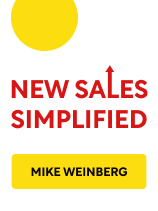

This article is an excerpt from the Shortform book guide to "New Sales Simplified" by Mike Weinberg. Shortform has the world's best summaries and analyses of books you should be reading.
Like this article? Sign up for a free trial here .
What exactly is a sales story? What information should you cover as you tell your prospects about your business and the products/services it sells?
Your sales story—the response you give when someone asks you to tell them about your business—is the centerpiece of any sales effort. An effective sales story focuses on the problems you solve for customers and the ways your solution is different from and better than anyone else’s.
In this article, we’ll discuss the importance and the characteristics of a compelling sales story, and some things to consider as you draft one of your business.
Why a Compelling Sales Story Is Important
Because it’s used so often, companies and sales teams need to get their sales story right before they can effectively use almost any other selling tool. Yet most companies don’t have a coherent, consistent, effective sales story because they’ve just assumed everyone knows what their company is all about.
Try this test at your company—ask your colleagues, “What’s our company all about?” People may be momentarily stumped. They may offer a marketing slogan, or ramble on with statements like: “We’ve been serving the community for 75 years, we have unique processes, our people are our most important resource,” and so on. Even many CEOs can’t give a succinct, compelling response. And everyone will likely have a somewhat different story.
An effective sales story contributes to increased sales because:
1) It fuels confidence and pride for the company and its offerings: When salespeople have a powerful sales story, they feel good about the company and themselves. They can thus sell with passion, driven by the belief that they create value and solve problems for customers.
2) It overcomes buyer resistance: Most salespeople launch into a presentation focused on the company and its products rather than on how it meets customer needs. Customers resist being bombarded with a pitch, especially if it doesn’t seem relevant to them. A good sales story effectively counters resistance and indifference because it leads with the problems, opportunities, and outcomes most important to the client.
3) It differentiates the company from competitors by emphasizing what makes your solution unique: Buyers will attest that most salespeople sound alike: They give the same presentations and demos, using the same words and tone of voice. However, coming across as different in your phone call or voicemail sparks the interest that gets you that first meeting. In addition, you must differentiate yourself from competitors to justify premium pricing; you must sell the customer on the value you create for the price. Conversely, you don’t need skill or a great sales story to sell a product if you have the lowest price.
Characteristics of an Effective Sales Story
Following are some essential characteristics of a sales story:
- It’s not about you: Remember that customers, and especially prospects, want to know what you can do for them, as opposed to how great your company is or the details of its history, products, and processes. Your story must pass the “so what?” test. When you start with a spiel on what you provide or do, the customer is always thinking, “So what?” (or, alternatively, they’re thinking, “We have that already.”)
- It’s reality-based: Your sales story must match reality—if it’s puffery that isn’t backed up by the company’s capabilities, performance record, and the customer’s brand experience, it won’t resonate. A phony story also is demotivating and embarrassing for salespeople.
- It’s compelling: Good stories and good storytellers draw people in—the listener becomes part of the story. In a good sales story, the customer is the protagonist (the customer, not the product is at the center). The story matters because, as the explanation of your brand, value and customer experience, it’s the gift-wrapping around your pitch or proposal.
(Shortform note: For more on storytelling in business, read our summary of Building a Storybrand.)
Drafting a Compelling Sales Story
This section looks at how to draft an effective, client-focused, differentiating story. An effective sales story has three components:
- It explains the customer issues you solve.
- It briefly states the solutions and services the company offers.
- It differentiates the company from competitors.
It’s important to start with customer issues because:
- It immediately gets the prospect’s attention.
- It changes the dynamics of the sales process—instead of resisting you like all other salespeople, the client is drawn into a dialogue about the issues they face.
- It allows you to establish yourself as a professional who understands and can solve their problems.
- It positions you to ask exploratory questions about these issues later in the sales process.
The Sales Story Format
The sales story should be a one-page encapsulation of how your company helps clients that can be presented or read in two or three minutes. Here’s what it should look like, using the example of a company that provides security services:
1) Headline: A sentence or two introducing your company so potential customers can quickly categorize it. This provides context for the sales story.
- Example: Safety First Inc. is the top provider of security services in the Northeast. We work with businesses and property managers to provide comprehensive, integrated security.
2) Transitional phrase and client issues: An introductory phrase intended to pique the prospect’s interest. It names the type of businesses you serve or client job titles.
- Example: Building owners choose Safety First Inc. … or Senior marketing executives look to Taylor Communications …
After the introductory phrase, list a half dozen client issues that you address in bullet-point format.
- Example: Building owners choose Safety First Inc. when … they’re concerned that their current security firm isn’t projecting a professional image.
3) Your company’s offerings: A few short, unembellished sentences ticking off what you sell. This part of your story is the least compelling to the client, so don’t dwell on it.
- Example: We provide an integrated service of professionally trained security guards, mobile response, and up-to-date electronic monitoring and alarm systems.
4) Your differentiators: A concluding statement or phrase followed by about five compelling reasons your company does a better job than anyone else at solving the problems you’ve presented.
- Example: “Safety First Inc. dominates the security market in the Northeast because we offer the best comprehensive service available. We provide integrated solutions. We handle crisis situations quickly and professionally. We provide fully qualified and vetted security officers.”
Putting the Pieces Together
Here’s a condensed example showing how Weinberg weaves the pieces together into a sales story for his sales coaching business:
- “I’m a sales coach who specializes in training sales teams to develop new business. CEOs turn to me in when current sales methods aren’t working and the sales team isn’t getting the results the company needs. I coach sales reps and team managers in my proven prospecting methods.”
Start Outlining a Sales Story
Here’s a team exercise for outlining a sales story.
1) Begin with three sheets of paper (one for each key part of the story: client issues, differentiators, offerings) and your company’s marketing materials and recent sales proposals.
2) Create a list of client issues by brainstorming answers to questions such as:
- Why did our best customers turn to us?
- What problems were they trying to solve?
- What problems did they have with previous providers?
- What hassles and frustrations did they have that we eliminated?
- What opportunities were they missing?
3) Ask a few of your top customers:
- Why did you choose our company?
- What results were you seeking or what were you aiming to achieve?
- What issues did you want to address?
- How has our solution benefited your business?
4) Examine your marketing materials for additional ideas on what your company achieves or what problems it solves (don’t get sidetracked by why your company is so great).
5) Discuss and narrow your client issues list to a half-dozen points and describe them in a compelling way.
6) Create a list of differentiators or compelling reasons your solution is different from and better than anyone else’s—for example, cite your unique expertise, proprietary methods, or service guarantees.
7) Spend only a few minutes listing your company’s offerings in a few brief sentences.
8) Over time, continue to tweak and revise this first draft. Carry it with you for a while and make notes as you think of improvements.

———End of Preview———
Like what you just read? Read the rest of the world's best book summary and analysis of Mike Weinberg's "New Sales Simplified" at Shortform .
Here's what you'll find in our full New Sales Simplified summary :
- A step-by-step plan for strategically selecting sales targets
- How to develop sales weapons
- How to consistently generate new sales






